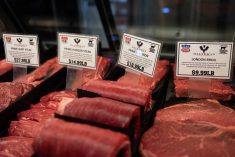Crop markets in early 2025 will likely be subdued as production prospects in South America appear good and the outlook for global trade is on edge, fearing U.S. president-elect Donald Trump’s threats about levying harsh tariffs and a potential renewed trade war with China.
In the Southern Hemisphere, Australia has mostly completed its harvest with excellent crops in Western Australia more than offsetting drought-pinched results in South Australia.
Total production of all crops is seen as the fifth largest ever, but rain just before harvest means the country will have more feed wheat than usual.
Read Also

India slaps 30 per cent import duty on yellow peas
India has imposed a 30 per cent duty on yellow pea imports with a bill of lading date on or after Nov. 1, 2025.
In South America, Brazilian farmers are generally happy with the progress of their soybeans. Moisture is excellent in central and northern soybean areas, but it is a little dry in the southern-most state, Rio Grande do Sul.
The U.S. Department of Agriculture forecasts Brazil’s soy crop at 169 million tonnes, up from 153 million last year. Brazilian forecasters think it could be 171 million tonnes.
Argentina is also hoping for a larger crop than last year, but December weather was dry in parts.
The USDA in December raised its Argentine soy forecast to 52 million tonnes, up one million from the month before and up about four million over last year.
The worry is that the current good state of Argentina’s crop could deteriorate quickly in the heat of the Southern Hemisphere summer if rain does not materialize soon.
The chance of good rain is diminished by the onset of La Nina, with its cooler water in the equatorial Pacific Ocean.
La Nina has been forecast for a while, but while it was slow in developing it has now reached the threshold to be official. The U.S. weather service expects a 59 per cent chance of it continuing in the February to April period.
La Ninas tend to reduce rainfall in Argentina and southern Brazil, but this La Nina is weak and might not have a big impact.
Only time will tell.
There is also a policy development in a Southern Hemisphere country.
Indonesia, the world’s largest producer of palm oil, planned to increase its mandate for palm oil-based fuel to 40 per cent from the current 35 per cent on Jan. 1 but has delayed implementation. It might be only a temporary thing.
If it moves to 40 per cent, it will remove some palm oil from international trade and provide modest support for global vegetable oil prices.
Earlier during the fall, Indonesia’s plan to move to a 40 per cent fuel mandate was one of the factors that helped vegetable oil prices rally, with canola enjoying the support.
The U.S. produced a huge soybean crop, which weighed on prices, but at the same time, the global production of canola, sunflower seed and palm was down.
The latter three are important sources of vegetable oil, and the trade expected that buyers would have to purchase more soybean oil to make up for the short supply of alternatives.
That helped soy oil futures rally. The March contract climbed 18 per cent from Sept. 1 to Nov. 11.
In the same period canola rallied almost 11 per cent.
But both contracts fell sharply during the rest of November after Donald Trump won the U.S. presidential election and began to ramp up his threats to slap high tariffs on China, Canada and Mexico.
This increased the potential of a renewed U.S.-China trade war that would likely again cause China to limit or block its imports of American soybeans.
Vegetable oil in the second half of November was also weakened by a decline in crude oil prices as worries over a wider war in the Middle East eased. Also, demand for crude was weaker than expected.
Soy oil has started to rise again in the opening days of January, supported by the dry weather in Argentina, rising oil prices triggered by more U.S. sanctions against Russia’s oil trade and the USDA’s January supply and demand report that trimmed the size of the American soybean harvest.
The USDA now pegs the soybean crop at 4.366 billion bushels, below expectations for 4.453 billion bu. Year-end stocks are now seen at 380 million bu., well below trade expectations for 457 million.
The USDA also lowered its estimate of U.S. corn production and year-end stocks. That helped corn prices to rally.
Canola’s price has also partly recovered from the recent low set in late November, supported by the same factors that lifted soy oil and also the strong export and domestic processing pace that canola has enjoyed so far this crop year.
The Canadian dollar’s slide down below US70 cents has also supported canola’s price.
Trump’s threats to levy heavy tariffs against Canadian goods has weakened the loonie.
It is also under pressure because the Bank of Canada, dealing with a weaker economy with less threat of rebounding inflation, has cut interest rates more aggressively than the U.S. Federal Reserve.
The Bank of Canada started cutting interest rates in June and since then has lowered them by 1.75 percentage points to 3.25 percent.
The Fed began cuts in September and since then lowered them by one percentage point to a range of 4.25 to 4.5 percent.
With the U.S. interest rate still relatively high, it has caused the U.S. dollar to rally against most other major currencies.
From Nov. 1 to Jan. 10, the loonie fell 3.44 per cent against the U.S. buck, the Japanese yen fell 3.96 per cent, the British pound fell 5.43 per cent, the euro fell 5.77 per cent and the Australian dollar fell 6.24 per cent.
Both the U.S. and Canada had better than expected December jobs reports. The central banks will likely see this as indicating the potential for inflation to remain a problem, even though prices are not rising as much as they were earlier last year.
That means there will likely be no more interest rate cuts for at least the next several months.















